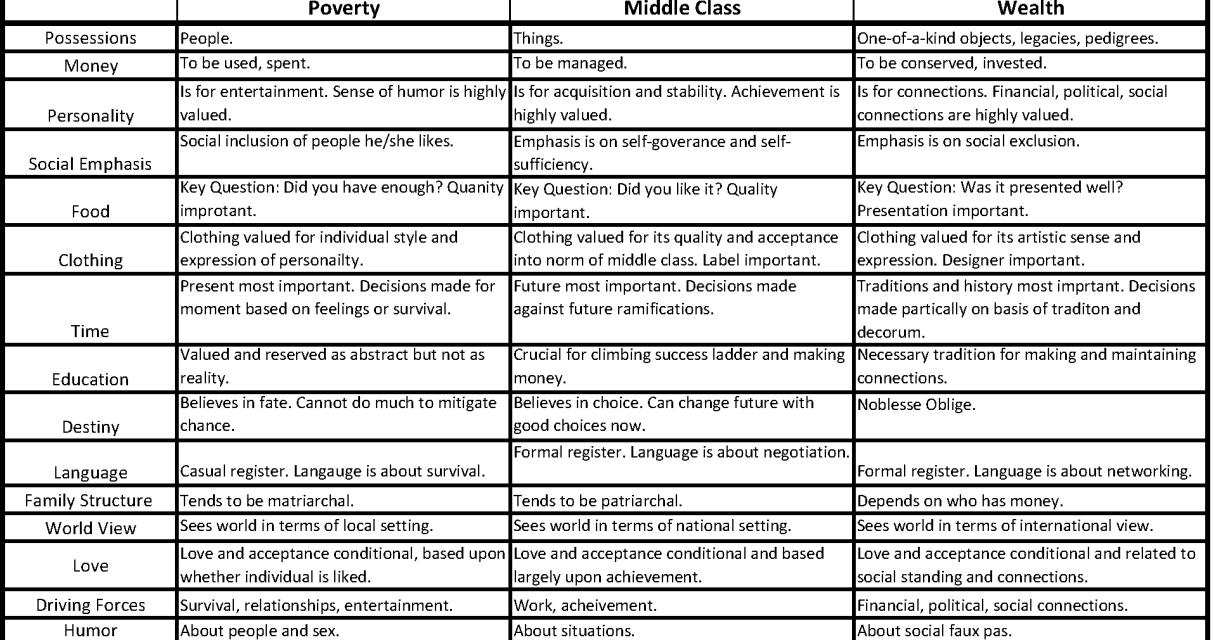Insight Blog
Agility’s perspectives on transforming the employee's experience throughout remote transformation using connected enterprise tools.
7 minutes reading time
(1435 words)
Hidden Rules Among Classes | UPDATED 2024 | A Complete Guide
Hidden Rules Among Classes Many of the attitudes that those in poverty bring with them are an integral part of their culture and belief systems.
Most of the attitudes that people living in poverty carry with them are ingrained in their culture and beliefs. When other, more feasible options are available, middle-class solutions should not be forced. Understanding the culture and ideals of poverty may help people feel less enraged and frustrated while dealing with persons who are poor. The unsaid indications and practices of a group that may be useful to you are described in the "hidden rules."
Hidden Rules Among Classes
The hidden rules among classes have made their way throughout the internet, but they are often uncredited. The book in which they were initially published has gone through at least five editions, and the content has been widely altered and repurposed.
According to several experts, her veracity assertions were made without any proof to back them up. Anthropological, social, and other studies on poverty contradict them. Furthermore, the investigation revealed that the author's "Payne's" assertions may have misled the teachers.
Payne focused on the following things in her book:
- -Social structures
- -Class
- -Poverty
- -Culture of poverty
- -Gender, race, and ethnicity
- -Hidden rules
There are many other things discussed by her in the book, but we will focus on issues related to hidden rules among classes.
Payne describes in her book that the majority of persons in poverty may be identified by their adherence to the poverty guidelines "Poverty's hidden rules." As defined by Payne, "hidden rules" are rules that are the group's unspoken cues and habits. There are different cueing methods for different groups and economic strata. She explains that in poverty, the noise level is great; for example, the TV is usually on, and everyone may chat at the same time. The most significant information is nonverbal, and one of the key qualities of an individual to the community is the capacity to amuse. For any statements about hidden rules, Payne provides no citations. We do not know how secret rules were revealed to her, nor does she explain how they are intended to be concealed or from whom they are supposed to be hidden.
This method of "hidden rules" is important to Payne's viewpoint and one in which she claims exceptional skill. Payne, on the other hand, has done no study on hidden rules and provides no evidence to back them up.
Examples of Hidden Rules Among Classes
Payne draws a distinction between people who live in poverty and those who live in the middle class in terms of hidden rules. Poor people, according to Payne, see money as something to be spent, but middle-class people see money as something to be controlled. Money is viewed as an expression of personality among the impoverished, and it is utilized for amusement and relationships. The idea of utilizing money as a kind of security is deeply rooted among the middle and upper classes. For the impoverished, personality is for amusement, and a sense of humor is highly prized. Personality, on the other hand, is highly prized by individuals in the middle class who value acquisition, stability, and accomplishment.
Payne reminds the readers that persons in poverty see the present as the most important thing, and decisions are made at the moment based on sentiments or survival. In contrast, for the middle class, the future is most important, and decisions are made with future consequences in mind. Education is cherished and adored as abstract but not as reality by the poor, yet it is critical for people in the middle class to climb the success ladder and make money, according to Payne.
One major contrast between the classes is how the world is perceived, according to Payne. The middle class views the world in terms of a national image, whereas the poor perceive the world in terms of their personal surroundings. As far as we can discern, these portrayals of the poor and middle classes' views are absolutely false. We believe that we will be pardoned from supplying proof that many middle-class individuals like amusement and have a sense of humor or that many people who are in terrible financial straits worry about their futures on a regular basis.
Ruby Payne Hidden Rules Chart
There are three socioeconomic classes, according to Payne: the impoverished or poor, the middle class, and the affluent. She doesn't go into detail about her reasoning, nor does she explain how these three groups are related to one another or how each of them might contain different forms of socioeconomic position. In Payne's world, the majority of people are middle class, the poor account for around 12% of the population, and the affluent account for just about 6% of the population.
You can read Ruby Payne's hidden rules chart here.
Ruby Payne Poverty Chart
People are classified as being in poverty by Ruby Payne regardless of whether their salaries are below the poverty level; rather, Payne claims that the "poor" category applies to everyone who has adopted the "poverty culture's" "mindset." While an individual's money may rise, Payne claims that their mental patterns, social interactions, and cognitive techniques stay the same. Students from families with earnings over the poverty line may nonetheless display the same behaviors, attitudes, and beliefs as those from poor families, according to Payne. Payne contends that, while financial resources are significant, they do not explain the inequalities in people's ability to escape poverty or the reasons why so many people remain in poverty. Furthermore, the capacity to escape poverty is more reliant on non-financial resources than on financial ones.
More importantly, the term "poverty" is not a symbolic one in this context; it simply denotes a lack of money. Although this is a material condition rather than an ethical or behavioral one, Payne's assertions conceal this basic truth. This is significant because, according to Payne's statements, when one has adequate financial means, one "leaves poverty." The key of Payne's reasoning, as we'll see, is defining poverty as something other than material deprivation. You can read Ruby Payne's poverty chart by clicking here.
Hidden Rules of Social Class Questionnaire
It is important to understand that the author of "hidden rules of social class" uses the term "resources" to describe the various ways in which a person, family, or society might be endowed or bereft. In reality, she defines poverty as "the degree to which a person is deprived of resources. Financial resources, emotional resources, mental resources, spiritual resources, physical resources, support systems, relationships/role models, and understanding of hidden rules are the eight types of resources she outlines. Payne's descriptions serve to persuade educators that they can have some impact on their pupils' eventual poverty status. Individuals who learn to overcome a lack of resources, such as emotional stability and the correct sort of connections and acquaintances, will be able to overcome their economic situation. Failure to acquire these additional resources, on the other hand, is likely to result in incarceration since one is unfamiliar with the acceptable boundaries of behavior.
You can use the hidden rules of the social class questionnaire template to understand the level of poverty.
Note that the individual resources are defined as those that are accessible to an individual if she chooses to use them by drawing from her immediate surroundings. Individual resources may differ dramatically from one scenario to the next. Poverty is defined by a lack of resources rather than a lack of money. As a result of Payne's resource conceptualization, she is able to transfer poverty from a material to a behavioral world.
She goes to considerable lengths to portray the characteristics of disadvantaged households. Because generations are by definition family, her fundamental class concept of generational poverty is founded in families. Poverty comes from parents through a type of cultural heredity that the school must break. People regard themselves as holding one another as property in Payne's image of poor families, and she repeatedly emphasizes that people are owned or that when one is poor, people are one's only possessions. She describes a poverty-specific family structure in which the mother is always at the center, despite the fact that she may have several sexual partners. Payne's portrayals are quite similar to other notable reports, despite the fact that she does not know about the sources.
Categories
Blog
(2644)
Business Management
(325)
Employee Engagement
(213)
Digital Transformation
(177)
Growth
(121)
Intranets
(119)
Remote Work
(61)
Sales
(48)
Collaboration
(37)
Culture
(29)
Project management
(29)
Customer Experience
(26)
Knowledge Management
(21)
Leadership
(20)
Comparisons
(6)
News
(1)
Ready to learn more? 👍
One platform to optimize, manage and track all of your teams. Your new digital workplace is a click away. 🚀
Free for 14 days, no credit card required.

















